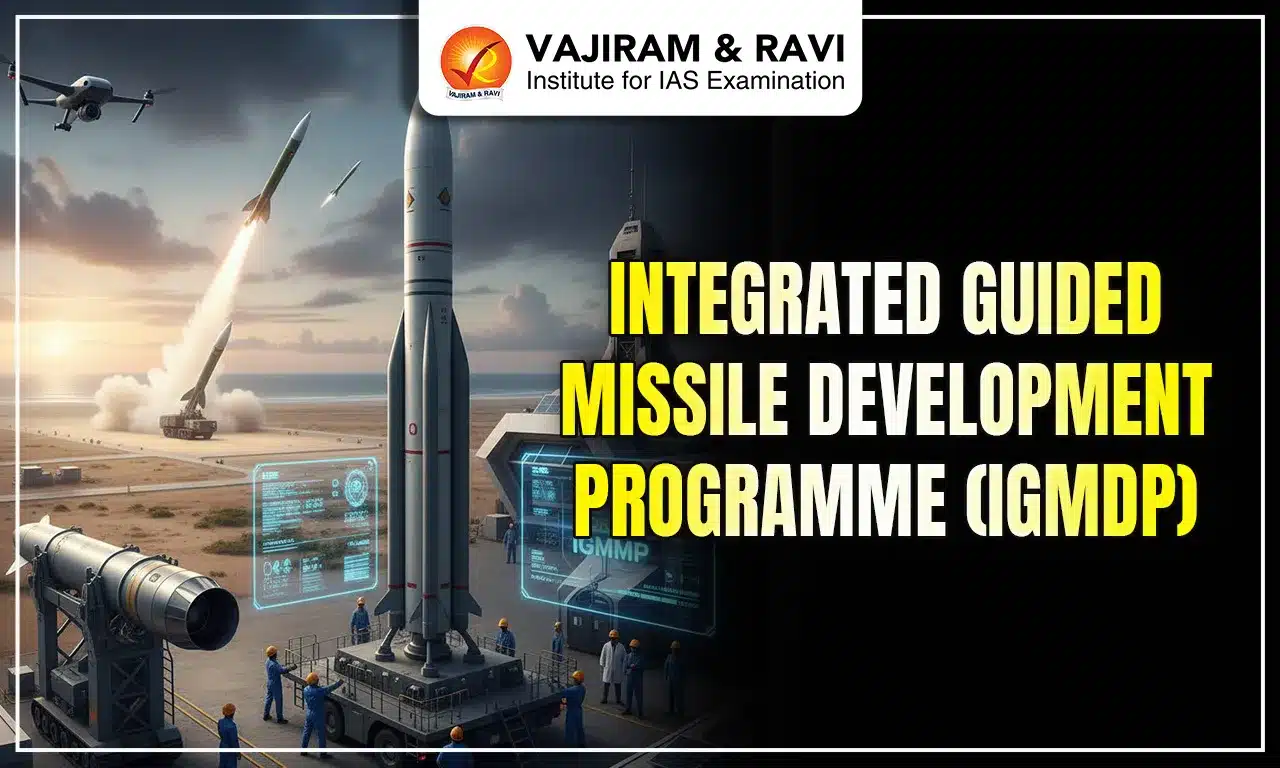The Integrated Guided Missile Development Program (IGMDP) was India's indigenous comprehensive missile development effort that commenced in the early 1980s. This ambitious initiative under the Ministry of Defence encompassed concurrently building expertise across multiple disciplines propulsion, navigation, control, materials etc. culminating in the operational Agni and Prithvi class surface-to-surface ballistic missiles conferring credible deterrence ability. Initiated in 1983 under the leadership of Dr APJ Abdul Kalam, IGMDP envisaged attaining self-reliance in missile technologies for national security priorities.
Background of the IGMDP
In the aftermath of the 1962 war with China and the 1965 & 1971 wars with Pakistan, India recognised the need for self-sufficiency in critical military hardware to support national security objectives. Missiles which featured prominently in these conflicts were primarily imported so far.
- However, realisation dawned that external dependency on tactical weapons in an uncertain world where suppliers’ geopolitical equations can rapidly shift is a vulnerability to be addressed.
- Thus in the late 1970s, a comprehensive Integrated Missile Development Program was formulated under the Defence Research and Development Organization (DRDO) to attain indigenous capability spanning battlefield rockets to long-range missiles.
- This later evolved into the IGMDP focused specifically on guided missiles.
Evolution of Integrated Missile Development Program
- Structured as a phased campaign, IGMDP progressed through technology development, sub-system testing, prototype fabrication, rigorous flight trials, production and eventual induction:
- 1983-84: Developing infrastructure and training scientific talent.
- 1984-89: Prithvi and Trishul missile advances.
- 1989-92: Mastering Nag anti-tank and Akash SAM missiles.
- 1992- 2008: Mature Agni ballistic missiles proving program success.
- The indigenised outputs enabled India to gatecrash the exclusive club of missile-possessing states - an indicator of technological proficiency conversion into strategic deterrence.
- The IGMDP program also delivered seminal spin-offs like the Long-Range Tracking System, advanced composite materials, high-accuracy ring laser gyros and radomes.
- It laid the foundations for the Integrated Missile Development Center, Defense Technology Center and the Advanced Center for Energetic Materials.
- 2008: After achieving the goal of making India self-reliant (Atma Nirbharta) the DRDO discontinued this program.
Objectives of the IGMDP
The IGMDP set ambitious objectives targeted at developing complete competence in guided missiles natively covering:
- Principal Technologies: The Integrated Guided Missile Development Programme established research facilities and hands-on mastery over dozens of technologies needed - propellants, aerodynamics, navigation, control systems etc.
- Production Infrastructure: This Program set up dedicated assembly lines and facilities so developed missiles can be manufactured in numbers efficiently.
- Deployment Capabilities: This Program enables the transition of successfully developed missile systems into the armed services through extensive field trials validation and induction into units.
Significance of Integrated Guided Missile Development Programme
The Integrated Guided Missile Development Program (IGMDP), initiated in 1983, played a pivotal role in consolidating indigenous expertise and operational capabilities in missile technologies:
- Indigenous development: By promoting research and development across surface-to-air, surface-to-surface and other missile categories,
- IGMDP enabled India to attain strategic autonomy rather than relying on imports.
- Cutting-edge platform: IGMDP provided a specialised platform for Indian scientists to gain proficiency by working on critical technologies like propellants, aerodynamics, navigation, guidance and stage separation.
- Strategic Deterrence: Successful missile development under IGMDP led to the creation of a deterrent force.
- Agni missile series, Prithvi missiles, BrahMos and Akash SAMs are now integral to national security management.
- Technological Spin-offs: IGMDP projects facilitated positive cascading effects, with missile infrastructure later adapted for civilian space and automotive advancements.
- International recognition: Bulk manufacturing, testing processes and infrastructure built via IGMDP also nurtured a formidable defence-industrial base, aligning with 'Make in India' goals.
Missiles Developed under IGMDP
Various ranges of missile systems developed under these projects are Prithvi, Trishul, Akash, Nag, and Agni.
Prithvi
It is a short-range surface-to-surface missile with varying range and payload capacity. Following are the different variants of the Prithvi missile.
- Dhanush is the naval variant of the Prithvi III missile, which can carry up to 500 kg-1000 kg for a strike range of 350 km. The submarine version is named Sagarika.

| Variants | Range | Payload | Fuel | Warheads | Status |
| Prithvi-I | 150 km | 1,000kg | Single-stage liquid-fueled | Nuclear, high-explosive | Inducted |
| Prithvi II | 350 km | 350 kg to 750kg | Single-stage liquid-fueled | Nuclear or Conventional | Inducted |
| Prithvi III | 750 km |
1,000 kg for 350 km & 500kg for (650km) 250 kg for 750 km |
1st stage is Solid-fueled 2nd stage- liquid-fueled. |
Nuclear or Conventional | Inducted |
Trishul
- The system has been developed to defend naval vessels against missiles and short-range surface-to-air missiles on land.
- It is a short-range, low-level, surface-to-air missile.
- It is capable of a strike range of 12 km.
- It is capable of carrying a load of 5.5 kg.
- India officially shut down this programme on 27 Feb 2008.
Aakash Missile

- Akash is a medium-range surface-to-air missile.
- It is capable of intercepting up to the range of 30 km.
- It can fly with supersonic speed- Mach 2.5.
- It has a launch weight of 720 kg.
- It can reach an altitude of 18km.
Nag
- It is the3rd generation, fire-and-forget anti-tank missile.
- It has been developed to strike and neutralise enemy tanks under the range of 500 meters to 4000 meters.
- The missile is launched from the NAG missile carrier(NAMICA) which is capable of carrying up to six combat missiles.
- Nag missile carrier is a BMP-II-based system with amphibious capability.
- The missile uses an 8 kg high-explosive anti-tank (HEAT) tandem warhead capable of night strike capabilities as it uses an Imaging Infra-Red guidance system.
- It can be mounted on an infantry vehicle; a helicopter-launched version will also be available with integration work being carried out with the HAL Dhruv.
- The helicopter-launched version of Nag is known as Helina.
Agni

Agni series of missiles are surface-to-surface ballistic missiles that can carry nuclear as well as conventional payloads. There are currently six operational missiles of which Agni-1 to Agni-3 were completed during the programme and the rest of the Agni missiles have been developed through independent projects.
| Variants | Range | Payload | Fuel | Warhead | Status |
| Agni I | 700 km- 1200 km | 750kg to 1000kg of | Single-stage solid propellant |
Conventional & Nuclear |
Inducted |
|
Agni-P (Agni-1 Prime) |
1,000 - 2,000 km | 1000kg | Two stages of solid propellant |
Conventional & Nuclear |
In trial |
| Agni II | 2500 km | 1000kg | Two-and-a-half-stage solid propellant |
Conventional & Nuclear |
Inducted |
| Agni III | 3,500 km | 1500 kg to 2500 kg | Two-stage solid propellant |
Conventional & Nuclear |
Inducted |
Way Forward
To consolidate leadership in the revolutionary field of guided weapon systems, ongoing efforts target frontier technology areas:
- Maneuverable Reentry Vehicles (MaRVs): Enhanced precision and penetration aids to defeat anti-missile systems through radical trajectory shaping possible via progress jet vanes, atmospheric friction and modelling.
- Decoys and Jammers: Sophisticated countermeasures including flares, chaff, jamming warheads and receiver saturation methods to overwhelm increasingly complex anti-missile interceptors through multi-spectral signature manipulation.
- Scramjet Hypersonic Cruise Missiles: Wings integrated scramjet ramjet-rocket combined cycle propulsion promising sustained Mach 6-8 attack flight profiles matching ballistic missiles in range with the advantage of level flight offering persistent ISR and flexible manoeuvre.
- Longer Range Agni Variants: Boosted operational readiness through canisterised storage, heavier MIRV payloads, networking and regular testing of road-mobile over 5000 km IRBMs continuing technology upgradation.
Last updated on January, 2026
→ Check out the latest UPSC Syllabus 2026 here.
→ Join Vajiram & Ravi’s Interview Guidance Programme for expert help to crack your final UPSC stage.
→ UPSC Mains Result 2025 is now out.
→ UPSC Notification 2026 is scheduled to be released on January 14, 2026.
→ UPSC Calendar 2026 has been released.
→ UPSC Prelims 2026 will be conducted on 24th May, 2026 & UPSC Mains 2026 will be conducted on 21st August 2026.
→ The UPSC Selection Process is of 3 stages-Prelims, Mains and Interview.
→ Prepare effectively with Vajiram & Ravi’s UPSC Prelims Test Series 2026 featuring full-length mock tests, detailed solutions, and performance analysis.
→ Enroll in Vajiram & Ravi’s UPSC Mains Test Series 2026 for structured answer writing practice, expert evaluation, and exam-oriented feedback.
→ Join Vajiram & Ravi’s Best UPSC Mentorship Program for personalized guidance, strategy planning, and one-to-one support from experienced mentors.
→ UPSC Result 2024 is released with latest UPSC Marksheet 2024. Check Now!
→ UPSC Toppers List 2024 is released now. Shakti Dubey is UPSC AIR 1 2024 Topper.
→ Also check Best UPSC Coaching in India
IGMDP FAQs
Q1. What are the five major projects of the Integrated Guided Missile Development Programme?+
Q2. What was the aim of the Integrated Guided Missile Development Programme?+
Q3. Which Missile was developed as an Anti-Tank Tactic Missile?+

















